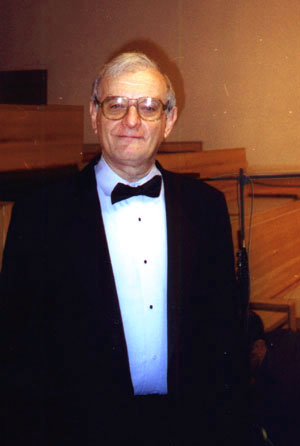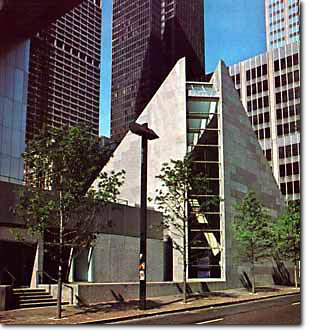Los Angeles, CA, December 3, 2000
This past Sunday, I had the great pleasure of attending Fred Swann’s annual Christmas concert at the First Congregational Church of Los Angeles. This would be his last regular Christmas concert at the church inasmuch as he has announced his retirement from the church organ bench after 60 years of service as a church organist, to be effective in May 2001.
(Incidentally, the program notes indicated that Dr. Somerville, Minister of Music, will also be retiring at that time, along with soprano Kathie Freeman.)
Although Dr. Swann has only been at First Congregational about three years, he obviously is already greatly loved and admired, as evidenced by the near-capacity audience who turned out for his concert: Most of the folks in attendance looked more like “church folk” than “organ folk,” so this clearly was a great display of support and respect for him. The announcement of his retirement, although already generally known, was met with many sighs of sadness and shaking of heads, even a few daubing at teary eyes with hankies. (A nice church-like couple sitting in front of me were very unabashed FRED FANS, and showed their adoration for him throughout the concert.)
The program began with a prelude by the Master Ringers, a very fine handbell choir from Lake Avenue Congregational Church in Pasadena. (Despite a printed request in the program to “please listen in silence,” not everyone was doing so. Most notably certain inattentive ushers who were escorting people to their seats with audibly barked seating indications. To their credit, the handbelliers’ attention and focus were not diverted despite the insensitive distractions.)
Dr. Swann then laid out an excellent, varied program including some “new fare” along with just enough “old chestnuts” to keep the purple-haired little old ladies (of both genders) content.
Of course, every piece was excellently played. And the seemingly limitless diversity of the Great Organs of the church was marvelously and ingeniously displayed.
We heard quaint touches of “klein-tinkelen und Farten-regalen” in Buxtehude’s choral fantasia on “Wie schön der Morgenstern.” (I heard a teenage kid behind me ask his mom if that was “a song about Rhoda Morgenstern!”)
The organ’s many ranks of lovely, lovely strings were slushed out in full force for Stanley Roper’s arrangement of the original orchestral version of Vaughan Williams’ “Greensleeves.” Absolutely blissful sounds here, layer upon layer of Shimmering Strings and Velvety Voxes. (Who was it who quipped, “More souls are saved with Chimes and Vox Humanas than any other stops in the organ!”)
The full force of the organ was called upon several times to thrilling, thunderous climaxes: Dr. Swann brilliantly played Simon Preston’s hair-raising “Alleluyas” and the captivatingly joyous “Grand Fantasia on ‘Joy to the World'” by Marc Cheban, a young organist from Philadelphia.
There were also the expected rooty-toots on the heart-stopping Holzgraf Memorial Trumpet, but it did appear to me that these trumpets have been reined in a bit as they did not seem as overbearing (indeed, nearly unbearable!) as they originally were.
Dr. Swann concluded the concert with Henri Büsser’s “The Sleep of the Infant Jesus.” My, my, my, my, MY. How can I begin to relate the sweet beauty of this work! Dr. Swann told about how during his tenure at Riverside Church, this piece always took a special and cherished place at the end of each annual Christmas Eve Candlelight service. He then gently requested that there be no applause at the end, “and you will see why.”
At the conclusion of the sublime work, a beautiful soprano voice eerily floated out into the nave seemingly out of nowhere–at once softly emanating from every pore of that sanctuary— singing, a cappela, “Silent Night.”
As the voice grew in intensity, we realized it was coming from a resonant hallway or stairwell behind the altar. The ethereal voice continued to grow in strength as the soprano, Kathie Freeman, slowly made her way out into the sanctuary. What a sweet, tender, peaceful moment. This brilliantly thoughtful treatment perfectly rendered the aural fragrance of the lovely, simple carol. Time seemed to stand still, and we very much felt the gentle presence of Our Creator there with us.
Finally Dr. Swann led us in rousing congregational singing of favorite Christmas carols, led by Kathie Freeman; although she had some stiff competition against the hundreds of ranks of organ and the sanctuary filled with concertgoers!
The concert was then over and done with, seemingly far too soon; and we reluctantly filed out of the gorgeous sanctuary to go back to our “regular lives.” However, even two days after the concert I am still blessed with a quiet peacefulness that has brought into my heart the true spirit of Christmas.
Afterward, Dr. Swann’s many admirers lined up in the cheerfully elegant, tastefully appointed fellowship hall (incongruously christened “The Barnum Room”) below the sanctuary to express their greetings, well wishes, and accolades for the concert, which easily was the best and most enjoyable in recent memory.
– – – – – – –
Here is the complete program:
3:45 Gathering Music
The Master Ringers, Handbell Choir
Lake Avenue Congregational Church
Pasadena – Jeremy Langill, director
4:00 Welcome
Thomas Hunter Russell, Assistant Organist,
Organ Concert Series Chair
Two Settings of the Advent Hymn “Veni, Veni Emmanuel”
Toccata – Andrew Carter
Meditation – Sir Edward C. Bairstow
Choral Fantasia – “Wie schön der [Rhoda] Morgenstern” – D.Buxtehude
Christmas, Op. 80 – Arthur Foote
Two Carol Variations – Max Drischner
“Lo, How a Rose ‘ere Blooming”
“In dulci jubilo”
Alleluyas – Simon Preston
Pastorale on “Forest Green” – Dale Wood
(Harp, Handbells, Organ)
(Jo Ann Turovsky, harp)
Grand Fantasia on “Joy to the World” – Marc Cheban
I n t e r m i s s i o n
Two Spanish Carols for Organ – Norberto Guinaldo
“¿Què li darem a n’el Noi de la mare?”
“El desembre congelat”
Greensleeves – R. Vaughan Williams
Variations on a French Carol – “Il est né le divin enfant” – Henri Büsser
The Sleep of the Infant Jesus – Henri Büsser
(Violin, Harp, Organ)
(Jo Ann Turovsky, harp)
(Steve Scharf, violin)
Silent Night – Kathie Freeman, soprano
Congregational Carol Singing, led by Dr. Swann and Kathie Freeman
Reception in the Barnum Room
©2000 Charlie Lester http://www.137.com

 The minimalist modern architecture of St Peter’s was a perfect background for the highly spiritual music of Bach. Having never visited St Peter before, I was struck with it’s architect’s flight of imagination. I certainly have never seen a church where the sanctuary was below ground level, with ceiling windows facing the street. Several people were glued to the glass during the performance, and that created a feeling that the organ was speaking not only to us, sitting below, but also to the people outside, and to the sky, and to the entire city.
The minimalist modern architecture of St Peter’s was a perfect background for the highly spiritual music of Bach. Having never visited St Peter before, I was struck with it’s architect’s flight of imagination. I certainly have never seen a church where the sanctuary was below ground level, with ceiling windows facing the street. Several people were glued to the glass during the performance, and that created a feeling that the organ was speaking not only to us, sitting below, but also to the people outside, and to the sky, and to the entire city. BINGEN – It’s almost unbelievable: In spite of little advertising, even “unspectacular” organ concerts find their audience. Indeed, the listeners in the well-attended Catholic Church in Büdesheim were more than rewarded.
BINGEN – It’s almost unbelievable: In spite of little advertising, even “unspectacular” organ concerts find their audience. Indeed, the listeners in the well-attended Catholic Church in Büdesheim were more than rewarded.